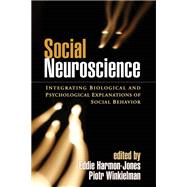
Note: Supplemental materials are not guaranteed with Rental or Used book purchases.
Purchase Benefits
What is included with this book?
| Introduction | |
| A Brief Overview of Social Neuroscience | p. 3 |
| Emotion Processes | |
| The Importance of Emotion-Social Cognition Interactions for Social Functioning: Insights from Orbitofrontal Cortex | p. 15 |
| Neurobiology of Emotion Recognition: Current Evidence for Shared Substrates | p. 31 |
| Ten Years of Research with the Trier Social Stress Test-Revisited | p. 56 |
| I Know How You Feel: Social and Emotional Information Processing in the Brain | p. 84 |
| How Thinking Controls Feeling: A Social Cognitive Neuroscience Approach | p. 106 |
| Motivation Processes | |
| Asymmetrical Frontal Cortical Activity, Affective Valence, and Motivational Direction | p. 137 |
| Reward: Neural Circuitry for Social Valuation | p. 157 |
| A Biobehavioral Model of Implicit Power Motivation Arousal, Reward, and Frustration | p. 176 |
| Vigilant and Avoidant Responses to Angry Facial Expressions: Dominance and Submission Motives | p. 197 |
| Attitudes and Social Cognition | |
| Attitudes and Evaluation: Toward a Component Process Framework | p. 227 |
| A Social Cognitive Neuroscience Model of Human Empathy | p. 246 |
| How Dynamics of Thinking Create Affective and Cognitive Feelings: Psychology and Neuroscience of the Connection between Fluency, Liking, and Memory | p. 271 |
| The X- and C-Systems: The Neural Basis of Automatic and Controlled Social Cognition | p. 290 |
| An Evolutionary Perspective on Domain Specificity in Social Intelligence | p. 316 |
| Person Perception, Stereotyping, and Prejudice | |
| Mechanisms for the Regulation of Intergroup Responses: Insights from a Social Neuroscience Approach | p. 353 |
| Social Cognitive Neuroscience of Person Perception: A Selective Review Focused on the Event-Related Brain Potential | p. 376 |
| Social Neuroscience and Social Perception: New Perspectives on Categorization, Prejudice, and Stereotyping | p. 401 |
| Interpersonal Relationships | |
| Neuropeptides and the Protective Effects of Social Bonds | p. 425 |
| The Quiet Revolution of Existential Neuroscience | p. 439 |
| Affiliative Responses to Stress: A Social Neuroscience Model | p. 454 |
| The Social Neuroscience of Relationships: An Examination of Health-Relevant Pathways | p. 474 |
| Index | p. 493 |
| Table of Contents provided by Ingram. All Rights Reserved. |
The New copy of this book will include any supplemental materials advertised. Please check the title of the book to determine if it should include any access cards, study guides, lab manuals, CDs, etc.
The Used, Rental and eBook copies of this book are not guaranteed to include any supplemental materials. Typically, only the book itself is included. This is true even if the title states it includes any access cards, study guides, lab manuals, CDs, etc.